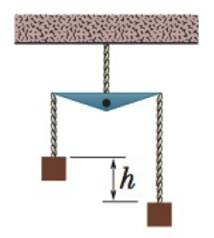
Concept explainers
In Fig. 13-57, identical blocks with identical masses m = 2.00 kg hang from strings of different lengths on a balance at Earth's surface, The strings have negligible mass and differ in length by h = 5.00 cm, Assume Earth is spherical with a uniform density ρ = 5.50 g/cm3. What is the difference in the weight of the blocks due to one being closer to Earth than the other?

Figure 13-5? Problem 100.
Want to see the full answer?
Check out a sample textbook solution
Chapter 13 Solutions
Fundamentals of Physics Extended 10E WileyPlus 5 Student Package
Additional Science Textbook Solutions
University Physics with Modern Physics (14th Edition)
The Cosmic Perspective
Essential University Physics: Volume 2 (3rd Edition)
University Physics Volume 3
Physics for Scientists and Engineers, Technology Update (No access codes included)
Glencoe Physics: Principles and Problems, Student Edition
- The average density of the Sun is on the order 103kg/m3 . (a) Estimate the diameter of the Sun. (b) Given that the Sun subtends at an angle of about half a degree in the sky, estimate its distance from Earth.arrow_forwardThe acceleration due to gravity on the surface of a planet is three times as large as it is on the surface of Earth. The mass density of the planet is known to be twice that of Earth. What is the radius of this planet in terms of Earth’s radius?arrow_forwardThe mean diameter of the planet Mercury is 4.88106m , and the acceleration due to gravity at its surface is 3.78m/s2 . Estimate the mass of this planet.arrow_forward
- Problem 5: A painter (of mass 71 kg) needs to reach out from a scaffolding to paint the side of a building, so he lays a plank across two bars of the scaffolding, and puts a heavy bucket of mass 27 kg directly over one of the bars (see figure). You can assume the plank is massless, and is long enough to reach to the other building. L d If the bars are separated by a distance 1.5 m, how far, d, from the bar on the the right can the painter walk before the plank starts to fall? d= m 9 HOME sin() cos() tan() J ( ) 7 8 cotan() asin() acos() E 1시 신 4 atan() acotan() sinh() 5 6 7 * 1 2 3arrow_forwarda 5.0-kg block is taken to another planet that has the same mass as the Earth. What is the planet’s radius if the object weighs half on that planet as it would on Earth? Let R be the radius of Earth.arrow_forwardThe weight of the homogeneous rod is 500N and its length is 5m Find the angle of inclination of the weight of the homogeneous rod that will keep it in equilibrium on the smooth surfaces on which it is placed хθ the rod from the horizonarrow_forward
- a 300 kg cylinder that is horizontal. Three steel wires support the cylinder from a ceiling.Wires 1 and 3 are attached at the ends of the cylinder, and wire 2 is attached at the center. The wires each have a crosssectional area of 2.00 * 10-6 m2. Initially (before the cylinder was put in place) wires 1 and 3 were 2.0000 m long and wire 2 was 6.00 mm longer than that. Now (with the cylinder in place) all three wires have been stretched.What is the tension in (a) wire 1 and (b) wire 2?arrow_forwardA non-homogeneous bar is 50 cm long and its linear density is given by the function λ(x)=32 + 25x² , where x is the position of the bar from one end, where λ is given g/m (grams per meter). a) Draw a sketch of the bar and mark where on the bar its center of mass is locatedb) Calculate the total mass of the rod.arrow_forwardInternational computer communications are often carried by optical fibers in cables laid along the ocean floor. If one strand of optical fiber weighs 1.75x10-3 lb/m, what is the mass (in kg) of a cable made of six strands of optical fiber, each long enough to link New York and Paris (9.84 x103 km)?arrow_forward
- you have been given indentical solid cylinders of three substances, oak, aluminum and styrofaom. Each of the solid substances are going to be dropped into liquid ethyl alcohol. you know that each cylinder has a radius of 5cm and a length of 8cm. you also know the weight of the substances are as follows Oak 4.3N, Alyminum 16.6N, styrofoam 0.03N. Determine whether each cylinder will sink, float or be neutral. show work.arrow_forward4 3- 2- Find the volume of the solid obtained by rotating the region bounded by y = z', y = 0, and a = 2, around the y-axis. Volume =arrow_forwardA spherical balloon filled with nitrogen is attached to a 2.5-m-long, 0.055-kg string. The balloon has radius 0.40 m. When released, it lifts a length h of the string when it comes to rest. Find h. Assume the mass of the balloon material is 0.251 kg.arrow_forward
 Classical Dynamics of Particles and SystemsPhysicsISBN:9780534408961Author:Stephen T. Thornton, Jerry B. MarionPublisher:Cengage Learning
Classical Dynamics of Particles and SystemsPhysicsISBN:9780534408961Author:Stephen T. Thornton, Jerry B. MarionPublisher:Cengage Learning University Physics Volume 1PhysicsISBN:9781938168277Author:William Moebs, Samuel J. Ling, Jeff SannyPublisher:OpenStax - Rice University
University Physics Volume 1PhysicsISBN:9781938168277Author:William Moebs, Samuel J. Ling, Jeff SannyPublisher:OpenStax - Rice University Physics for Scientists and Engineers: Foundations...PhysicsISBN:9781133939146Author:Katz, Debora M.Publisher:Cengage Learning
Physics for Scientists and Engineers: Foundations...PhysicsISBN:9781133939146Author:Katz, Debora M.Publisher:Cengage Learning


